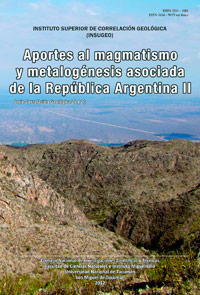Serie Correlación Geológica 28 (2)
Geología y geofísica del cuerpo máfico-ultramáfico Las Cañas, Provincia de San Luis
Andrés Carugno Durán | Augusto Morosini | Ariel Ortiz Suárez | Humberto Ulacco
Descargar trabajo en formato PDFResumen
El cuerpo de las Cañas se ubica al NE de la provincia de San Luis, es un intrusivo de forma alargada y concordante según la estructura de la roca de caja. Su tamaño alcanza 800 metros de ancho por 2 kilómetros de largo. Se aloja en esquistos pertenecientes al Complejo Metamórfico Las Aguadas (Complejo Metamórfico Conlara) de esquistosidad de rumbo regional N 20 a 30º E y buzamiento de alto ángulo al este. La roca predominante es un gabro que muestra estratificación magmática, reconociéndose sectores ultramáficos de hasta 50 metros de diámetro, que en partes son hornblenditas piroxénicas formadas por cristales poiquilíticos de anfíbol con inclusiones de clinopiroxeno, olivino alterado y minerales opacos. Estas rocas muestran alteración y mineralización de Ni, Cr, Fe, Zn y elementos del grupo del platino. El relevamiento geomagnético terrestre revela una anomalía en la zona mineralizada coincidente con los sectores ultramáficos, con picos positivos y negativos de 1.955 y -480 nT próximos entre si. Contrastes de aproximadamente 500 nT de amplitud caracterizan al cuerpo ígneo sin mineralización, mientras que las rocas metamórficas de la caja raramente superan los 100 nT de amplitud. Las características geoquímicas indican que el cuerpo de Las Cañas está formado por dos grupos de rocas, unas con altos valores de MgO y otras predominantemente toleíticas, en el primer caso poseen valores máximos entre 2 y 22 ppb de Pt o Pd.
Abstract
GEOLOGY AND GEOPHYSICS OF THE LAS CAÑAS MAFIC-ULTRAMAFIC STOCK, SAN LUIS PROVINCE. Las Cañas is an elongated stock located to the NE of San Luis province. Its structure is concordant with that of the country rock and has a size of 800 m wide by 2 km long, located in schists belonging to the Las Aguadas Metamorphic Complex (Conlara Metamorphic Complex) with N 20º - 30º schistosity and an eastward high angle dip. The predominant facies is a gabbro that shows magmatic stratification and contains ultramafic sectors of up to 50 m in diameter; in some cases the rock is a pyroxenic hornblendite formed by poikilitic amphibole crystals with inclusions of clinopyroxene, altered olivine and opaque minerals. These rocks show alteration and mineralization of Ni, Cr, Fe, Zn and platinum group elements. The geomagnetic terrestrial survey reveals an anomaly in the mineralized zone that coincides with the ultramafic rocks, with positive and negative peaks of 1955 and -480 nT that are close to each other. Contrasts of approximately 500 in nT amplitude characterize the igneous body without mineralization, whereas the metamorphic host rocks rarely exceed 100 nT. The geochemical features indicate that the Las Cañas body is formed by two groups of rocks, one with high values of MgO and the other predominantly tholeitic, with the former case possessing between 2 and 22 ppb of Pt or Pd.






